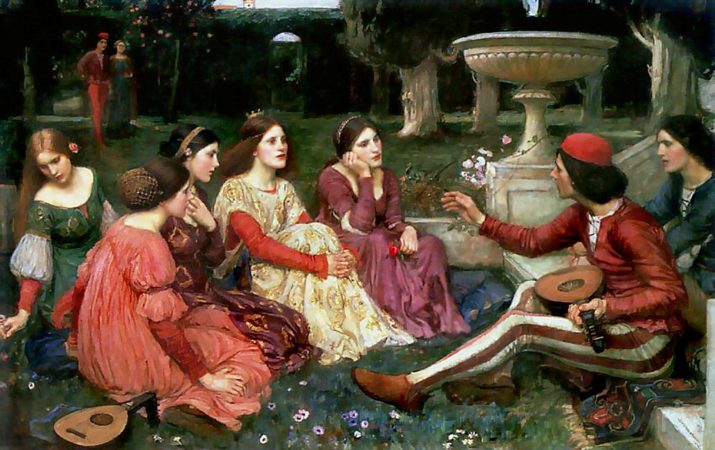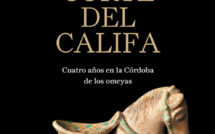

This is part of a series on the Novel Coronavirus (COVID-19) pandemic.
The Decameron is having a comeback. The fourteenth-century Italian masterpiece is “on Everyone’s Coronavirus Reading List” and “shows us how to survive coronavirus.”[1] Decameron-inspired book clubs and collections of Coronavirus tales are popping up all over the Internet.[2] Commentators have astutely recognized the similarities between Giovanni Boccaccio’s description of plague-stricken Italy and our new normal as COVID-19 wreaks havoc across the globe.[3]
Reading these recent pieces, one might believe that the Decameron is mostly about the Black Death of 1348, but the plague takes up a relatively tiny fraction of the work. After the Introduction, Boccaccio’s brigata—the group of seven young women and three young men who narrate the Decameron’s tales—escapes ravaged Florence. Safely in the countryside, they do not ruminate on the conditions of the plague. They imagine life beyond it. Although Boccaccio laments the dissolution of social bonds in his Introduction, the hundred stories recounted by the brigata raise different questions: Which bonds are worth saving? How should we live? For whom should we have compassion? And how should we structure society once the plague has passed?
The Decameron’s trick is that it does not offer a simple answer. For centuries, critics have disputed which stories are serious and which are parodic, which characters deserve our sympathy and which our censure, and what, if any, is its overarching message.[4] I could hardly summarize, let alone intervene in, the numerous debates here. But, as my friend and colleague Alyssa Falcone recently reminded me, there is one piece of the Decameron that we can hold onto throughout its multi-layered, multi-valent tales—the work’s opening line: “It is a human trait to have compassion for the afflicted” [umana cosa è aver compassione per gli affliti].[5] Thinking about that first sentence, I find myself drawn to two specific stories—one tragic, one comic—that make us confront and critique society’s hierarchies, that ask us how we might imagine a more equitable and compassionate community.
The two novellas (Decameron IV.1 and VI.7) recount how their female protagonists—Ghismonda and Filippa—engage in sex outside the bounds of traditional marriage. However, the outcomes of the tales differ drastically: Ghismonda takes her own life, while Filippa emerges unscathed. In these stories, women’s perceived sexual transgressions (and the responses to them) reveal societies characterized by imbalanced political power and hierarchies of gender and class. And although Filippa’s outcome is, in many ways, more desirable (she is, after all, not dead) than Ghismonda’s tragic end, both ask us to reimagine a world in which all humans, or any human, is seen as worthy of society’s compassion.
The story of Ghismonda unfolds on the fourth day, when the brigata tells tales that end tragically. Ghismonda is a widow, full of longing, but her father, the Prince of Salerno, is reluctant to find her a new husband. After careful consideration, Ghismonda decides she will, in fact, satisfy her desires but only with a man of worth. She chooses Guiscardo—a lowly-born but favorite servant of her father’s, an extremely honorable and trustworthy man. The two enjoy each other’s company; however, their romance is cut short when Ghismonda’s father discovers that she has taken Guiscardo as a lover, becomes enraged, chastises her for her unscrupulous decisions, and arrests Guiscardo.[6]
At the story’s climax, Ghismonda offers an articulate and reasoned defense of her actions in which she elaborates a philosophy of compassion and equality that challenges her father’s unchecked power. Tancredi, however, is unmoved by Ghismonda. He remains unable to recognize those who are different from him—Ghismonda and Guiscardo—as fully human. He thus becomes a cautionary example of what happens when those in power refuse to have compassion, and, instead, reduce others to their status in a hierarchy—in this case, gender and class. Although Ghismonda ultimately fails to convince Tancredi, the reader can’t help but feel compelled by her insightful and compassionate argumentation. Her final act—to take her own life after the execution of her beloved—reinforces her humanity and Tancredi’s lack of empathy. The tragic conclusion leaves the reader wishing for a different world in which Ghismonda’s life might have been spared.
From his first confrontation with Guiscardo, Tancredi’s objectification of Ghismonda and his lack of compassion are evident:
Guiscardo, my benevolence towards you deserved a better reward than the shameful deed I saw you committing today, with my own eyes, against that which belongs to me. [Guiscardo, la mia benignità verso te no avea meritato l’oltraggio e la vergogna la quale nelle mie cose fatta m’hai].
Tancredi’s statement resonates with a line from an earlier story. In Decameron II.6, the nobleman Currado rebukes Giannotto for sleeping with his daughter:
How great an injury you have done to me in the person of my own daughter. [la ‘ngiuria la quale tu m’hai fatta nella mia propria figliouola.]
But in Currado’s rendering, the injury has been done to him via his figliuola, his daughter, whereas in IV.1, Tancredi laments an affront to his cose, literally, his possessions.[7] Currado’s reprimand maintains his daughter’s sense of humanity while Tancredi’s strips Ghismonda of even the basic human relation that bonds her to him.
Where Tancredi objectifies Ghismonda and belittles Guiscardo, she makes a case for shared humanity. Ghismonda reminds him:
You are made of flesh and blood, Tancredi, and it should have been obvious to you that the daughter you fathered was also made of flesh and blood and not of stone or iron. [Esser ti dové, Tancredi, manifesto, essendo tu di carne, aver generata figliuola di carne e non di pietra o di ferro].
Ghismonda also responds to his criticism that Guiscardo is unworthy on account of his low social status. She counters this faulty logic by voicing the principle that virtue is not available solely to the noble or rich:
You will see that we are all of one flesh and that our souls were created by a single Maker, who gave the same capacities and powers and facilities to each. [tu non vedrai noi d’una massa di carne tutti la carne avere e da uno medesimo Creatore tutte l’anime con iguali forze, con iguali potenze, con iguali vertù create].
Once again, Ghismonda invokes flesh, carne, employing the same word she used when emphasizing her shared humanity Tancredi. Her reasoning rejects Tancredi’s status as political or patriarchal power, undercutting hierarchies of gender, class, and even sovereignty in favor of an egalitarian value system.
Even as the reader is moved by Ghismonda’s call for equality, Tancredi is not, and his callousness has the most horrific of consequences: the execution of Guiscardo and the suicide of Ghismonda. Even if Tancredi is fully within his rights as Prince of Salerno to make such decisions, they are flawed—his choices wreak havoc on a harmonious social order and civic life. Once Tancredi realizes he has erred, it is too late. Yet although Ghismonda is dead, her reasoning, her principles, and her call to compassion are not. They live on, mixed with Tancredi’s remorse, asking us to imagine a different society based on shared humanity and equality—one in which Ghismonda might have survived.
Like Ghismonda, Filippa opts to satisfy her desires outside the bounds of marriage, and thus finds herself facing the consequences of such a sexual transgression. The story of Filippa, however, is told on a light-hearted day when the brigata recounts tales of protagonists who avoid unpleasant situations with quick wit. Caught in the arms of her lover, Filippa should be sentenced to death (a law that is out of line with reality, as scholars have noted, but reaffirms Filippa’s connection with Ghismonda).[8] Instead, appearing before the podestà (roughly the equivalent of a magistrate), she gives a witty response that wins her freedom and leads to the law’s amendment. Despite its happy ending, the tale returns to the same issues of power, societal hierarchies, and compassion found in the story of Ghismonda, and leaves the reader wondering, again, if there might be an even more desirable way to organize our world.
Again, the climax of the tale is the impassioned and logical speech given by the female protagonist before the male authority. When Filippa arrives to plead her case, she refuses to lie and insists upon defending her actions, just like Ghismonda. The judge demands Filippa to tell the truth, and she responds:
Sir, it is true that Rinaldo is my husband, and that he found me last night in Lazzarino’s arms, wherein, on account of the deep and perfect love I bear towards him, I have lain many time before; nor shall I ever deny it. [egli è vero che Rinaldo è mio marito e che egli questa notte passata mi trovò nelle braccia di Lazzarino, nelle quali io sono, per buono e per perfetto amore che io gli porto, molte volte stata, né questo negherei mai] (emphasis mine).
Ghismonda, similarly, swore that she was not willing to deny her actions or plead with her father, using the same verb as Filippa: negare, to deny. In crafting her response to Tancredi, Ghismonda also began “It is true that…” [Egli è vero che], acknowledging her transgression in order to defend it. These rhetorical structures link the speeches of Ghismonda and Filippa, encouraging us to see how similar their predicaments are but how divergent the outcomes.
Filippa’s justification for her actions, like Ghismonda’s, returns to the principle of equality. Filippa reminds the magistrate:
However, as I am sure you will know, every man and woman should be equal before the law, and laws must have the consent of those who are affected by them. [ma come io son certa che voi sapete, le leggi deono esser comuni e fatte con consentimento di color a cui toccano].
Filippa’s assertion derives from a legal concept, quod omnes tangit ab omnibus approbari debet [that which touches all must be approved by all]—a notion first found in sixth-century Justinian code and later adopted by Gratian in the twelfth century. Despite the fact that such a maxim was most likely never applied to women in the Middle Ages, Filippa’s biting tone highlights this hypocrisy.[9]
Yet, this argument of equality before the law is quickly pushed aside in favor of another. Filippa encourages the podestà to ask her husband if she has ever failed to satisfy him. Rinaldo, without hesitation, admits that Filippa has always consented to his desires. Filippa then inquires of the magistrate what is expected of her. Should she should be forced to throw her excess sexual desire “to the dogs?”[10] Wouldn’t it be better to give it to a worthy man rather than to let it go to waste? Despite privileging male sexual satisfaction within marriage—and perhaps pandering to men who would like to have their longings satiated by both their wives and mistresses—Filippa makes a case for a different kind of equality, the equality of women’s desires. Women desire as men do, should they not also be satisfied? Once men have had their fill, shouldn’t the women have theirs?
At this suggestion, almost all the people of the town of Prato who had come to see Filippa’s trial begin to laugh. And “as if with a single voice” [quasi a una voce] they demand that she be pardoned. Unlike Tancredi, the podestà, had already begun to “have compassion” [aver compassione] for the afflicted woman on account of her beauty and nobility. Moved by his feeling and the demands of the people, he releases Filippa and recommends that the statute be amended to punish only unfaithful women seeking payment. Rinaldo, embarrassed, returns home alongside a “happy” [lieta] and “free” [libera] Filippa.
Although Filippa is pardoned, Boccaccio’s tale reminds us that women remain particularly vulnerable to the compassion—or lack thereof—of those who wield power. Once we’re done laughing at Filippa’s clever response, we’re left wondering if the new modification to the statute and the end of the story is completely satisfactory after all. Would Filippa have survived if the podestà wasn’t moved by her nobility? What will happen to women still affected by the new statute? Should women have to rely on the compassion of men to simply stay alive?
Through the tales of Ghismonda and Filippa, Boccaccio forces us to interrogate our societal values and scrutinize the hierarchies that structure our world. It is imperative that we not only have compassion for one another as individuals, but that we create a society based on empathy and equality so that the power of one does not outweigh the power of many. We have the chance, in our lives beyond the plague, to align our values with their implementation, to demolish hierarchies that reduce people to categories or characteristics. We can (re)construct a community characterized by compassion and cooperation, one in which we embrace the maxim quod omnes tangit ab omnibus approbari debet, ensuring that what affects all is agreed upon by all. It may seem like a radical idea, but in the wake of tragedy, we have the chance not only to save our social bonds but to reinvent them.
The interpretations sketched here will undoubtedly be contested by some. But the beauty of the Decameron is precisely this multiplicity. As Boccaccio’s enigmatic volume becomes popular quarantine reading, I hope that we don’t think of it as simply “plague literature.” Rather, I encourage readers everywhere to embrace the challenge the Decameron presents to envision the lives and communities we will build beyond the plague.
Alyssa Granacki was a recipient of the Mellon-CES Dissertation Completion Fellowship and is currently a Postdoctoral Associate at Duke University. Her research interests include Italian literature, gender studies, manuscripts, and history of philosophy.
References:
[1] Norman Vanamee, “Decameron and Chill? Why a 14th-Century Italian Masterpiece Is on Everyone’s Coronavirus Reading List,” Town & Country. Published March 16, 2020. https://www.townandcountrymag.com/leisure/arts-and-culture/a31540805/decameron-sudden-popularity-coronavirus/. André Spicer, “The Decameron – the 14th century Italian book that shows us how to survive coronavirus,” The New Statesmen. Published March 9, 2020. https://www.newstatesman.com/2020/03/coronavirus-survive-italy-wellbeing-stories-decameron
[2] “100 Days of Decameron,” Iowa City of Literature. Accessed July 15, 2020. http://www.iowacityofliterature.org/decameron/. “The Decameron Project,” The New York Times. Published July 8, 2020. https://www.nytimes.com/interactive/2020/07/07/magazine/decameron-project-short-story-collection.html. “Coronavirus Tales,” Humanities Watch. Accessed July 15, 2020. https://humanitieswatch.org/coronavirus-tales/ A.J. Goldman, “Bringing Plague Tales Into Modern Times,” The New York Times. Published March 9, 2020. https://www.nytimes.com/2020/03/09/theater/kirill-serebrennikov-decameron-deutsches-theater.html . “The Decameron: a Virtual Production from Synetic Theatre,” Synetic Theater. Accessed July 15, 2020. https://synetictheater.org/event_pages/the-decameron/.
[3] Paula Findlen, “What Would Boccaccio Say About COVID-19?” Boston Review: A Political and Literary Forum. Published April 24, 2020. https://bostonreview.net/arts-society/paula-findlen-what-would-boccaccio-say-about-covid-19. Mark McLemore, “What “The Decameron,” a Medieval Italian Masterpiece, can tell us about life during a pandemic,” Arizona Public Media. Published March 25, 2020. https://news.azpm.org/p/news-topical-politics/2020/3/25/168252-what-a-medieval-italian-literary-masterpiece-can-tell-us-about-life-during-a-pandemic/?fbclid=IwAR2g1bE0je7WqjTuIhM5UWlIoGZSKTJ8Dybip7fCQZaDiXYgY8d3pbTsLbo. Michael Sherberg, “Some coronavirus lessons from Boccaccio,” The Source, Washington University in St. Louis. Published March 25, 2020. https://source.wustl.edu/2020/03/some-coronavirus-lessons-from-boccaccio/.
[4] See, for instance: Teodolinda Barolini, “The Wheel of the Decameron,” Romance Philology 36 (1983):521-539.
Victoria Kirkham, The Sign of Reason in Boccaccio’s Fiction (Firenze: Leo S. Olschki Editore, 1993). Millicent Joy Marcus, An Allegory of Form: Literary Self-Consciousness in the Decameron (Saratoga, CA: Animi Libri, 1979). Giuseppe Mazzotta, The World at Play in Boccaccio’s Decameron (Princeton: Princeton University Press, 1986). Marilyn Migiel, A Rhetoric of the Decameron (Toronto: University of Toronto Press, 2003), and The Ethical Dimension of the Decameron, (Toronto: Toronto University Press, 2015).
[5] Translation mine. All other English quotations are from Giovanni Boccaccio, The Decameron, trans. G. H. McWilliam, 2nd ed. (New York: Penguin Books, 1995) unless otherwise noted. Italian quotations are from Giovanni Boccaccio, Decameron, ed. Vittore Branca (Torino: Einaudi, 1992).
[6] Another convincing way to read this story is for its incestuous element; see Guido Almansi, The Writer as Liar: Narrative Technique in the Decameron (Boston: Routledge and K.Paul, 1975).
[7] In addition to its contemporary meaning as “thing,” in the fourteenth century, the word cosa was also used to indicate one’s goods, possessions, or merchandise to be sold. See Tesoro della Lingua italiana delle Origini, s.v. “cosa,” accessed February 24, 2020, http://tlio.ovi.cnr.it/TLIO/.
[8] Boccaccio was trained in canon law, so he certainly recognized that this was incorrect. See Kenneth Pennington, “A Note to Decameron 6.7: The Wit of Madonna Filippa,” Speculum 52.4 (1977): 902-905.
[9] On the unlikelihood of this statement applying to women, see Pennington.
[10] Potentially a parody of Matthew 15:26.
Photo: The Decameron | John William Watehouse
Published on July 17, 2020




